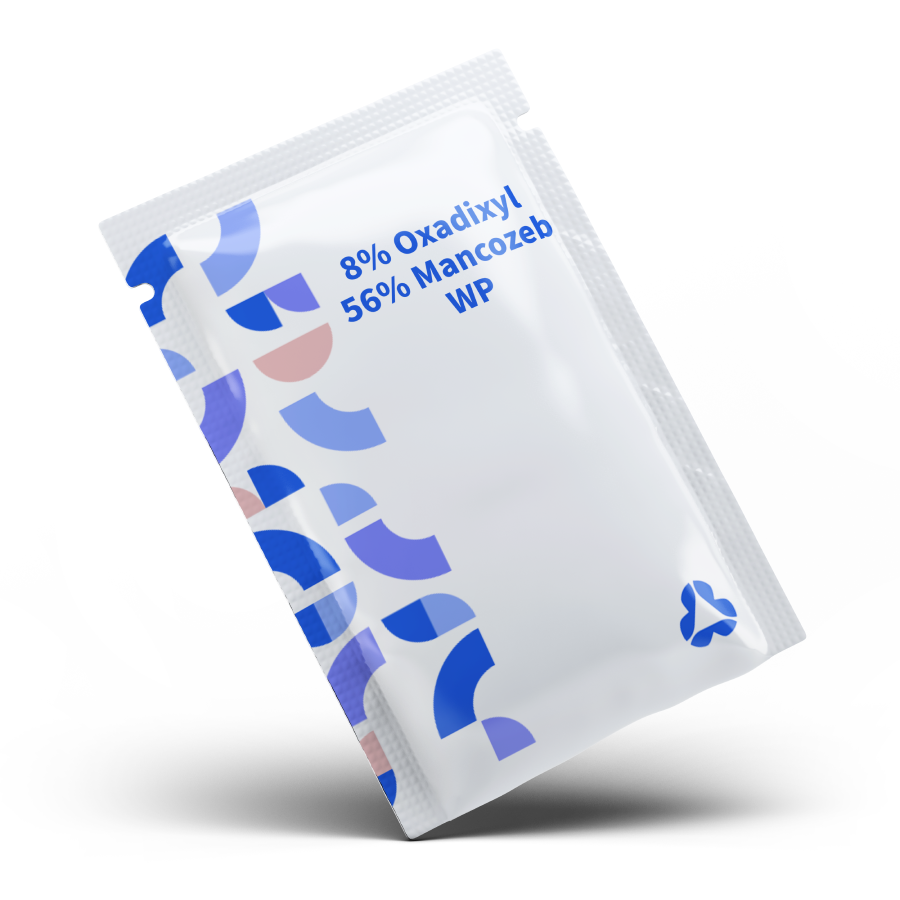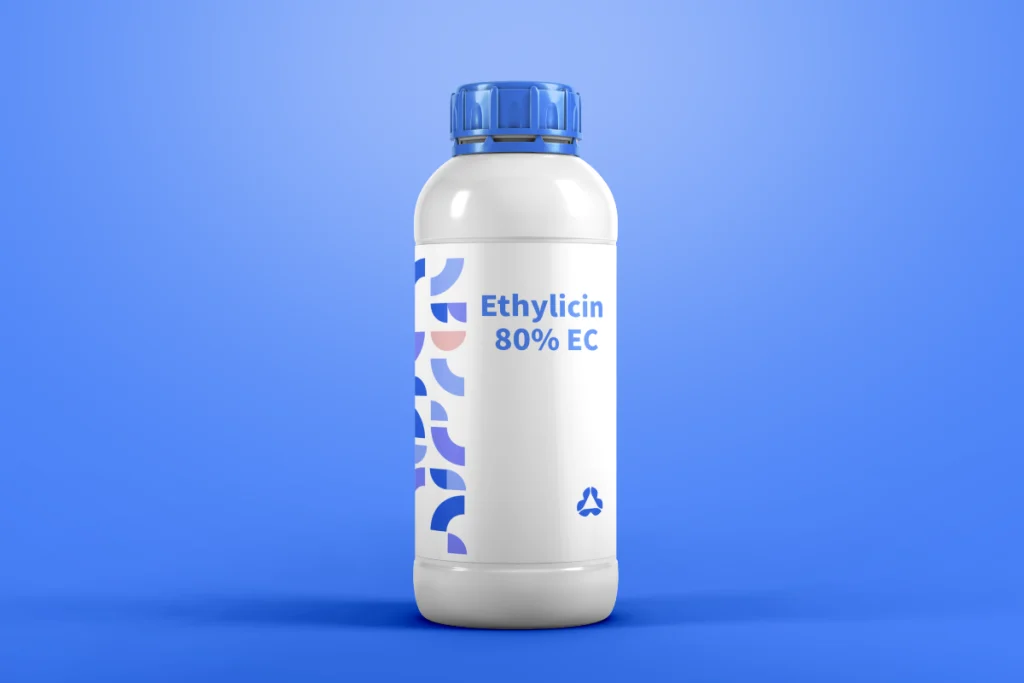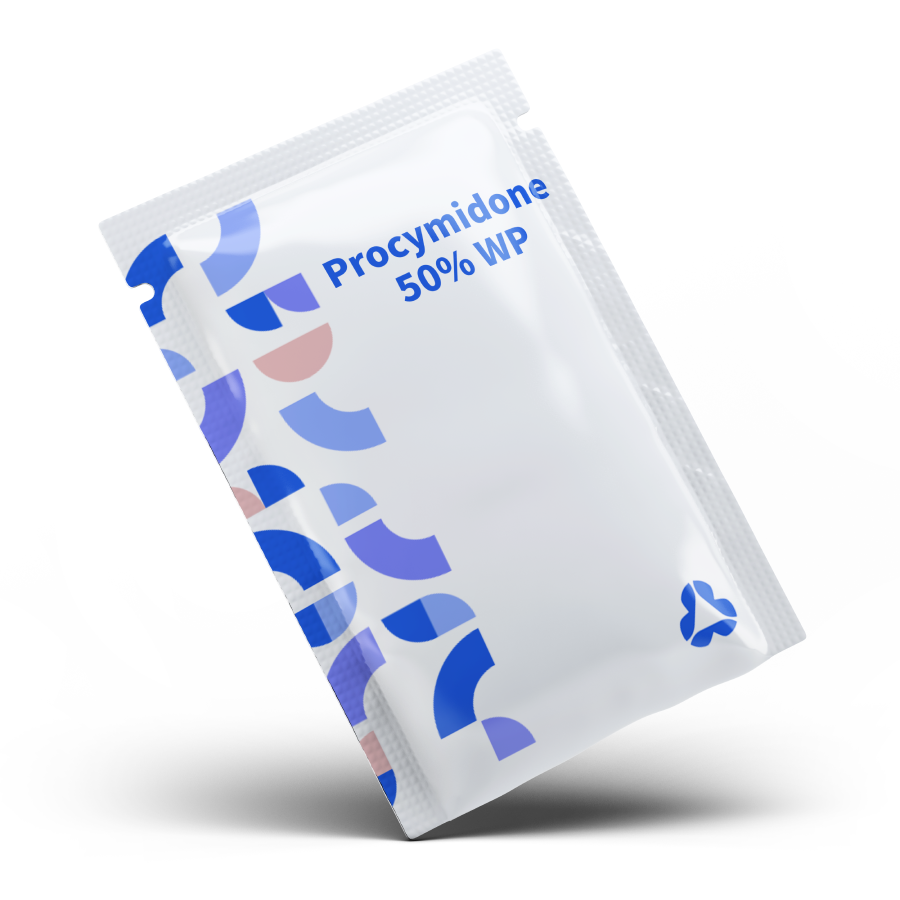- Mechanism: Inhibits β-tubulin synthesis in fungal cells, disrupting microtubule formation during mitosis → stops cell division and fungal growth.
- Systemic Activity: Absorbed by plants and translocated via xylem, providing internal protection to both treated and new growth.
- Action Types: Preventive (blocks spore germination) and curative (targets established infections).
| Crops |
Target Diseases |
Formulation & Method |
Dosage |
| Cereals (Wheat, Barley) |
Rust, leaf spot, Fusarium head blight |
Foliar spray (50% WP/80% WDG) |
1.0–1.5 kg/ha |
| Fruits (Apples, Grapes) |
Scab, anthracnose, powdery mildew |
Foliar spray (50% SC) |
1.0–1.5 L/ha |
| Vegetables |
Powdery mildew, downy mildew, blight |
Foliar spray (80% WP) |
0.8–1.2 kg/ha |
| Ornamentals |
Leaf spots, rust, powdery mildew |
Foliar spray (50% WP) |
0.5–1.0 kg/ha |
| Pulses (Peas, Beans) |
Anthracnose, root rot, blight |
Soil drench + foliar spray |
Varies by formulation |
- Single-Active Formulations:
- Wettable Powder (WP): 50% WP, 80% WP (foliar spray for broad coverage).
- Suspension Concentrate (SC): 50% SC (improved adhesion for foliar use).
- Water-Dispersible Granules (WDG): 80% WDG (ideal for systemic uptake).
- Combination Formulations:
- Carbendazim + Thiophanate-Methyl (35% + 46.5% WP)
- Carbendazim + Difenoconazole (50% + 5% WP)
- Carbendazim + Iprodione (15% + 5% SC)
- Broad-Spectrum Efficacy: Controls Ascomycetes, Basidiomycetes, and Deuteromycetes (e.g., Botrytis, Fusarium, Alternaria).
- Systemic Protection: Long-lasting (14–21 days residual) and protects new growth.
- Flexible Use: Suitable for pre-plant seed treatment (e.g., cotton seedlings at 1:100 dilution), foliar spray, and post-harvest storage.
- Tank Mix Compatibility: Can be mixed with insecticides and multi-site fungicides (avoid alkaline solutions).
- Pre-Harvest Interval (PHI): 14–21 days (e.g., 1500g/ha for wheat scab with 50% WP).
- Precautions:
- Wear PPE (gloves, goggles, mask) to avoid skin/eye contact or inhalation.
- Toxic to fish and algae; apply away from water bodies.
- Store in cool, dry conditions; keep away from food/feed.
- Environmental Impact: Moderate persistence in soil; avoid overuse to prevent resistance.
- Retail: 500g/1kg bags (50% WP), 1L bottles (50% SC).
- Commercial: 25kg drums (80% WP), 1000L IBCs (80% WDG).
- Custom: OEM/ODM services for branded labeling and regional formulations.
- IRAC Group: 1 (single-site mode of action) → rotate with Group M fungicides (e.g., mancozeb) for resistance management.
- Post-Harvest Use: Approved for dip treatments to extend fruit shelf life (e.g., citrus, bananas).
- Standards: Manufactured in ISO 9001-certified facilities; complies with FAO/WHO quality guidelines.
Carbendazim is a systemic fungicide belonging to the benzimidazole class. Its chemical formula is C₉H₉N₃O₂. It works by inhibiting β – tubulin synthesis in fungal cells. During fungal mitosis, microtubules are crucial for the proper segregation of chromosomes. By blocking β – tubulin synthesis, Carbendazim disrupts microtubule formation, which in turn stops cell division and fungal growth. It is absorbed by plants and translocated through the xylem. This systemic action means it can protect both the treated parts of the plant and new growth from fungal attacks. It has both preventive and curative properties. Preventively, it blocks spore germination, and curatively, it targets established fungal infections within the plant.
Carbendazim has broad – spectrum efficacy against a wide range of fungal pathogens. In cereals like wheat and barley, it controls rust, leaf spot, and Fusarium head blight. For fruits such as apples and grapes, it is effective against scab, anthracnose, and powdery mildew. In vegetables, it combats powdery mildew, downy mildew, and blight. In ornamentals, it helps manage leaf spots, rust, and powdery mildew. It also controls anthracnose, root rot, and blight in pulses like peas and beans. It is active against Ascomycetes, Basidiomycetes, and Deuteromycetes, for example, fungi like Botrytis, Fusarium, and Alternaria.
It can be used on a diverse range of crops. This includes cereals (wheat, barley), fruits (apples, pears, grapes, citrus, bananas), vegetables (tomatoes, cucumbers, melons, onions, garlic), pulses (peas, beans), and ornamentals (roses, ornamental shrubs, lawns). It is also used as a seed treatment for some crops like cotton seedlings.
Common single – active formulations include Wettable Powder (WP) such as 50% WP and 80% WP, which are suitable for foliar spray to achieve broad coverage. Suspension Concentrate (SC) like 50% SC offers improved adhesion for foliar applications. Water – Dispersible Granules (WDG) such as 80% WDG are ideal for systemic uptake by plants. There are also combination formulations, for instance, Carbendazim + Thiophanate – Methyl (35% + 46.5% WP), Carbendazim + Difenoconazole (50% + 5% WP), and Carbendazim + Iprodione (15% + 5% SC). These combination products are designed to expand the spectrum of disease control.
For foliar applications, it should be mixed with water according to the recommended dosage. The dosage varies depending on the crop, stage of growth, and severity of the disease. Generally, for many crops, the dosage might range from 0.5 – 1.5 kg/ha for WP formulations. For example, in wheat for rust control, 1.0 – 1.5 kg/ha of 50% WP or 80% WDG might be used. It should be applied evenly to ensure good coverage of the plant surfaces. Application is best done in the early morning or late evening when the temperature is cool and humidity is high. This helps the fungicide to adhere better and reduces the risk of evaporation. It can also be used as a soil drench in some cases, especially for controlling soil – borne diseases. When used as a seed treatment, the seeds can be treated by soaking them in a Carbendazim solution or coating them with a Carbendazim – containing powder.
Carbendazim can be mixed with many insecticides and some fungicides. However, it should not be mixed with alkaline substances as it is more stable in acidic conditions. When considering tank – mixing with other fungicides, it’s important to note that since Carbendazim has a single – site mode of action (IRAC Group 1), it is beneficial to mix it with multi – site fungicides like mancozeb. This combination can help manage resistance development. But always check the compatibility of the specific products in a small test batch first to ensure there are no physical or chemical reactions that could reduce efficacy, such as the formation of precipitates.
For human safety:
- Wear personal protective equipment (PPE) including gloves, goggles, and a mask to avoid skin and eye contact as well as inhalation. Carbendazim can be absorbed through the skin and if inhaled, may cause respiratory irritation.
- Avoid ingestion. In case of accidental ingestion, seek medical attention immediately.
For environmental safety:
- It is toxic to fish and algae. Therefore, avoid applying it near water bodies to prevent runoff and contamination of aquatic ecosystems.
- Carbendazim has moderate persistence in soil. Overuse can lead to the build – up of residues in the soil, which may affect soil microorganisms and potentially lead to resistance development in fungal populations.
Storage:
- Store Carbendazim in a cool, dry place away from food, feed, and heat sources. Keep containers tightly sealed to prevent moisture absorption, which could affect the product’s efficacy.
The pre – harvest interval varies depending on the crop. Generally, it ranges from 14 – 21 days. For example, for wheat scab control when using a 50% WP formulation at 1500g/ha, the PHI is typically 14 – 21 days. It is crucial to strictly follow the label instructions for each crop to ensure that residue levels on the harvested products are within the acceptable limits set by food safety regulations. This helps prevent excessive Carbendazim residues from entering the food chain.
Carbendazim has a single – site mode of action (IRAC Group 1). This means that fungi can relatively easily develop resistance to it over time if used repeatedly without proper rotation. To manage resistance, it is highly recommended to rotate its use with fungicides from different mode – of – action groups. For example, rotating with multi – site fungicides like mancozeb (IRAC Group M) can be an effective strategy. Multi – site fungicides act on multiple targets within the fungal cell, making it more difficult for fungi to develop resistance. Additionally, tank – mixing Carbendazim with fungicides of different modes of action can also help delay the onset of resistance.
Carbendazim is a synthetic chemical fungicide and is generally not permitted in organic farming systems. Organic farming emphasizes the use of natural, non – synthetic methods for pest and disease control. Instead, organic farmers may use alternative products such as copper – based fungicides (with proper restrictions due to copper accumulation concerns) or sulfur – based fungicides. These alternatives have different modes of action and environmental impacts compared to Carbendazim. Always check the specific organic certification requirements in your region as they may have detailed guidelines on approved and prohibited substances.
When stored correctly in a cool, dry place away from sunlight and moisture, Carbendazim typically has a shelf life of 2 – 3 years. Proper storage conditions are essential to maintain its efficacy. If the product is exposed to heat, humidity, or sunlight for extended periods, it may degrade more quickly, reducing its effectiveness in controlling fungal diseases.
Signs of phytotoxicity can include leaf burn, where the leaf tissue shows brown, scorched – looking areas. Chlorosis, or yellowing of the leaves, may also occur, indicating a disruption in the plant’s normal physiological processes. Stunted growth is another possible sign, with the plant not growing to its expected size or rate. These symptoms are more likely to occur in sensitive plant varieties, when Carbendazim is applied at excessive rates, or under certain environmental conditions such as high temperatures or strong sunlight. If phytotoxicity is suspected, it is advisable to stop using the product immediately and consult an agricultural expert for advice on how to mitigate the damage.




